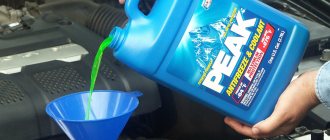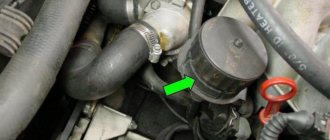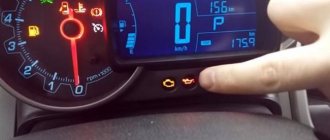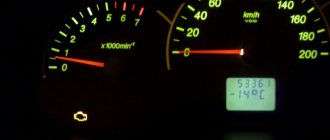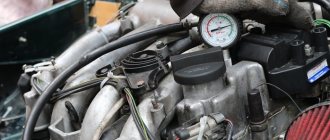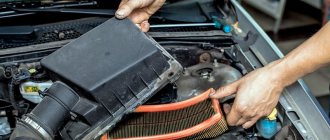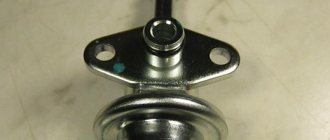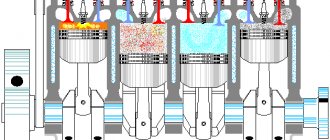Signs of decreased or lack of compression in the cylinders
List of possible “symptoms” of lack of compression in one, two or all cylinders of the internal combustion engine (internal combustion engine) of a vehicle:
- A malfunction of a diesel or gasoline engine, in which the power unit stops “pulling” - it does not start or starts with difficulty. The engine can be started by cranking the crankshaft for a long time using the starter mechanism. The inability to start is due to the fact that one of the cylinders (or all at once) has low pressure or it is zero.
- Engine operation has become unstable. The revolutions of the power unit float when idling, and while driving at speed they will be unstable. Different compression leads to a loss of normal power or to the fact that this parameter is completely absent after overheating or when cold.
- Increased fuel consumption.
- Problems with the cylinders. If the compression is bad and continues to fall, when driving uphill, a knocking sound from the hydraulic compensators appears (the “clatter” of metal under the hood). This problem is especially obvious if you drive with an injector or carburetor at low speeds.
- On diesel engines, the malfunction is accompanied by popping noises appearing in the internal combustion engine.
- With low compression in 1, 4 or other cylinders (up to 3, 5, 6, 7, 8, 9 atm (atmospheres)), the pressure level in the cooling system lines may increase. This will cause the system to begin to squeeze out refrigerant from under the sealing components. If there is no coolant and the car has leaks, it is necessary to test the compression in the third, fourth and other cylinders.
- The appearance of exhaust gases escaping in the engine compartment from the connection of the cylinder head (cylinder head) with the main module. This problem is usually due to damage or wear to the gasket.
Error code
It is important to know
P030X is an error code that appears when compression in one or more cylinders decreases on most modern cars.
This combination appears when there is a malfunction in the ignition system. Instead of the X symbol, the diagnostic equipment displays the number of the cylinder (for example, 10 or 16) in which the error was registered.
Video: what is the reason for the lack of compression
The “Motor P” channel talked about the “symptoms” and reasons why there is no compression in the engine cylinders
Signs of malfunctions with reduced compression when hot in different modes
If the compression is below the nominal value when the throttle valve is open, this indicates an air leak. It can go away when severe wear on the compression rings , significant scuffing on the bore of one or more cylinders, abrasion on the piston/pistons, a crack in the cylinder block or on the pistons, burnout or “hanging” in one position of one or more valves.
After taking measurements at a wide open throttle, you should check the compression with the throttle valve closed. In this mode, a minimum amount of air will enter the cylinders, so you can “calculate” the minimum air leaks. Typically, in this way it is possible to determine the deformation of the valve stem/valves, wear of the valve seat/valves , and burnout of the cylinder head gasket.
For most diesel engines, throttle position is not as critical as for gasoline power units. Therefore, they simply measure compression in two engine states - cold and hot. Usually with the throttle valve closed (gas pedal released). The exception is those diesel engines that are designed with a valve in the intake manifold designed to create a vacuum used to operate the vacuum brake booster and vacuum regulator.
It is advisable to carry out a hot compression check not just once , but several times, while recording the readings in each cylinder and at each measurement. This will also allow you to find faults. For example, if during the first test the compression value is low (about 3...4 atmospheres), and later it increases (for example, up to 6...8 atmospheres), then this means that there is wear on the piston rings, wear on the piston grooves, or scuffing has appeared on the cylinder walls . If, during subsequent measurements, the compression value does not increase, but remains constant (and in some cases may decrease), this means that air is leaking somewhere through damaged parts or their loose fit (depressurization). Most often these are valves and/or their seats.
Compression test when hot with oil added
The process of measuring compression in engine cylinders
When measuring, you can increase the compression by dropping a little (about 5 ml) of engine oil inside the cylinder. In this case, it is important that the oil does not get to the bottom of the cylinder, but spreads along its walls. In this case, the compression in the cylinder under test should increase. If the compression is low in two adjacent cylinders, and adding oil did not help, the cylinder head gasket is most likely broken . Another option is a loose fit of the valves to their seats, burnout of the valves, incomplete closure as a result of improper adjustment of the clearances , burnout of the piston or a crack in it.
If, after adding oil to the cylinder walls, the compression increased sharply and even exceeded the values recommended by the factory, this means that there is coking or stuck piston rings .
Additionally, you can check the cylinder with air. This will make it possible to check the tightness of the cylinder head gasket, piston burnout, and cracks in the piston. At the beginning of the procedure, it is necessary to install the diagnosed piston at TDC. Next, you need to take an air compressor and apply air pressure equal to 2…3 atmospheres to the cylinder.
If the head gasket is blown, you will hear the sound of air escaping from the adjacent spark plug well. If on carburetor machines the air in this case comes out through the carburetor, this means that there is no normal fit of the intake valve. You also need to remove the cap from the oil filler neck. If air comes out of the neck, then there is a high probability of a crack or burnout of the piston. If air comes out of the exhaust tract elements, this means that the exhaust valve/valve is not tightly attached to the seat.
Cheap compression meters often give a large measurement error. For this reason, it is also recommended to perform several compression measurements on individual cylinders.
In addition, it is useful to keep records and compare compression as the engine wears. For example, every 50 thousand kilometers - at 50, 100, 150, 200 thousand kilometers. As the engine wears, compression should decrease. In this case, measurements must be performed under the same (or similar) conditions - air temperature, engine temperature, crankshaft rotation speed.
It often happens that for engines whose mileage is about 150...200 thousand kilometers, the compression value is the same as that of a new car. In this case, you should not be happy at all, since this does not mean that the engine is in good condition, but that a very large layer of soot has accumulated on the surface of the combustion chambers (cylinders). This is very harmful for the engine, as it hinders the movement of the pistons, promotes sticking of the rings and reduces the volume of the combustion chamber. Accordingly, in such cases it is necessary to use cleaning products or it is time to overhaul the engine.
Conclusion
Compression testing is usually done “hot”. Its results can indicate not only its decrease, and therefore a decrease in engine power, but also help identify faulty elements in the cylinder-piston group, such as wear on the compression rings, scuffing on the cylinder walls, a broken cylinder head gasket, burnout or “freezing.” » valves. However, for comprehensive engine diagnostics, it is advisable to perform a compression test in different engine operating modes - cold, hot, with the throttle valve closed and open.
Compression and compression ratio are the same thing: the first fairy tale
No not like this! Compression is the pressure in the cylinder, the compression ratio is a dimensionless parameter that describes the geometric parameters of the cylinder: it is the ratio of the total volume of the cylinder to the volume of the compression chamber (the compression chamber is the volume of space above the piston at its position at TDC (it is also called the volume of the end of compression - this is the same thing). Calling it a combustion chamber is incorrect, since fuel combustion occurs throughout the entire volume of the cylinder.) Compression depends on the compression ratio, but the compression ratio does not depend on compression! Compression also depends on a bunch of parameters: compression start pressure, valve timing adjustment, temperature at which the measurement is carried out, leaks from the combustion chamber. And leaks are determined by wear of the rings and cylinders.
“Compression” is the maximum pressure that we measure in the cylinder when the ignition is turned off.
Signs of low compression in the engine.
The main signs of low compression are the presence of the following factors:
- The engine does not start well. The first sign of low compression in the engine may be the fact that the car begins to have difficulty starting. Of course, if this happens, this does not mean that an urgent engine overhaul is needed, but it is still worth thinking about.
- Increased oil consumption - the main sign of low compression is increased oil consumption. This is especially true for old German and Japanese cars.
- Unstable engine operation. With low compression, the engine will run unstably, but it is unlikely to seize or knock if you monitor the oil level and constantly add it. If you miss this moment, then oil starvation will occur, and then, with a high probability, the engine will knock and then seize.
- Loss of power. As mentioned earlier, with low compression the factory characteristics of the engine are lost. The engine power becomes less, the engine does not pull. Driving with the engine becomes very difficult.
- Blue smoke from the exhaust pipe. If you notice thick bluish smoke coming from the exhaust pipe, this indicates that engine oil is present during the combustion process. Which enters the combustion chamber due to stuck rings on the pistons.
There is no compression in the engine, what should I do?
LAND ROVER is not a car, but a state of mind.
This article will describe not only how compression is checked, but also what indirect signs precede its drop.
Signs of poor compression.
1) The engine starts poorly, as if in pursuit. First, one cylinder seizes, then with each revolution the other cylinders begin to seize.
2) The engine emits blue smoke.
Worn oil seals. Smoke appears when the gas is released to idle when the car is braking with the engine. If you rev the engine at the same time, a bluish cloud will appear behind the car. If you perform throttle changes with the engine, then when you release the gas there is no smoke, but when you press the gas, smoke appears.
Ring wear. The car starts to smoke when driving fast, especially when driving uphill. The oil filler neck, if you unscrew it and put it on the neck at XX, will jump up and down. But this is not the worst thing if, as the speed increases, the cap tends to come off the oil filler neck. This means your engine has a strong breakthrough of gases through the rings into the crankcase. (in this case, try cleaning the gas ventilation filter or the crankcase gas outlet control valve.)
How to check the level?
To find out about small or weak compression on spark plugs in the first, second or other cylinder of the engine, you must adhere to the following rules:
- the power unit must be spun up by the starter to extremely high speeds, for this it is necessary to reduce the likelihood of energy loss;
- the procedure should not be carried out on a cold engine in order to ensure maximum coupling at temperatures closest to operating temperatures;
- You must first turn off and unscrew the spark plugs from the cylinders to prevent the formation of resistance to rotation;
- you need to turn off the fuel supply so that the engine fluid is not washed off the cylinder walls;
- It is necessary to charge the battery as much as possible to effectively spin the crankshaft.
Using a compression gauge
To check the compression level using a compression meter:
- You need to warm up the car to operating temperature
- Relieve the pressure level in the fuel rail. Afterwards, you need to start the power unit again.
- The next stage of diagnosis, which will allow us to understand the cause of the drop in compression, will be the removal of the tips located on the spark plugs.
- At the next stage, you need to check whether the compression has dropped in all four cylinders of the engine.
Table: measurement results
| Cause of the problem | Symptoms of a problem | Compression level, MPa | |
| The damper is fully open | The damper is closed | ||
| The power unit is working properly | — | 1,0-1,2 | 0,6-0,8 |
| Crack or other defect in the piston bridge | the appearance of blue smoke from the muffler, increased pressure in the crankcase | 0,6-0,8 | 0,3-0,4 |
| Piston burnout |
| 0,5-0,5 | 0-0,1 |
| Rings sticking in piston grooves |
| 0,2-0,4 | 0-0,2 |
| Piston element and cylinder scuffing |
| 0,2-0,8 | 0,1-0,5 |
| Valve deformation | One or more engine cylinders cannot operate at low speeds | 0,3-0,7 | 0-0,2 |
| Valve burnout | One or more engine cylinders cannot operate at low speeds | 0,1-0,4 | 0 |
| Valve sticking | One or more engine cylinders cannot operate at low speeds | 0,4-0,8 | 0,2-0,4 |
| The appearance of a defect on the camshaft cam profile (for engines equipped with hydraulic tappets) | One or more engine cylinders cannot operate at low speeds | 0,7-0,8 | 0,1-0,3 |
| An increase in the volume of deposits and soot in the combustion chamber along with wear of the rings and valve stem seals | Increased consumption of engine fluid, blue smoke coming from the exhaust pipe | 1,2-1,5 | 0,9-1,2 |
| Natural wear of piston group elements | Increased consumption of engine fluid, blue smoke coming from the exhaust pipe | 0,6-0,9 | 0,4-0,6 |
Oil check
The oil test is carried out using 15-20 grams of lubricant, which is poured into an incorrectly operating cylinder.
Then you need to check:
- thermal clearances of valves on each cylinder;
- motor;
- lubricant.
Then the engine is assembled and started, and the cooling system expansion tank is diagnosed.
Video: checking compression without using a compression gauge
The Secret GARAGE channel presented a video showing a way to check the pressure in the engine cylinders without using compression equipment.
How to check compression?
For measurements, a device called a compression meter is used.
In fact, it is a dial pressure gauge with a flexible hose having a threaded tip, a check valve that provides a sufficient level of sealing, a handbrake for bleeding air and resetting the readings, as well as possible adapters for different threads, which is important for checking the compression of diesel engines since they contain measurements are carried out through different holes of the injectors or glow plugs. Two people are involved in the measurement. One is located inside the car - turns on the ignition, turns the starter, while pressing the gas pedal to the floor, thereby fully opening the throttle. The other one directly takes measurements from the outside.
Measurement algorithm:
– make sure that the battery is charged, the ignition system and specifically the starter are in good condition; – start the engine and warm it up to approximately 80°C;
– turn off the engine and de-energize the fuel pump in any way, for example, by pulling out the corresponding fuse; – unscrew the spark plugs, and on the diesel engine injectors and screw the compression gauge nozzle into place first; – depress the gas pedal as much as possible and turn the starter a few revolutions – usually 5-7 revolutions are enough; – take the resulting pressure gauge reading; – unscrew the pressure gauge from the socket of the first spark plug, screw it into place of the second, repeat the operation and so on for each cylinder.
As a result of measuring the compression in the engine, real values of pressure in the cylinders will be obtained, from which conclusions can be drawn about the condition of the power unit. Deviations not exceeding 10% from the norm between cylinders are considered normal. If there is greater scatter and low compression, this means that air is “leaking” from the cylinder and you should think about ways to increase compression or repair.
Compression may also be higher than normal due to large deposits and an increase in the compression ratio.
You can try to find out the reasons for the pressure drop in the “problem” cylinder through additional measurements, which are carried out by pouring 50 ml of engine oil into the suspicious cylinder and re-measuring the compression. The results of the check may be two options. The first is that the pressure remains low. This means that air leaks from above, for example, through a burnt-out valve or through the cylinder head gasket. Second, the pressure has increased significantly. This may indicate, for example, coking of the piston rings.
Other measurement methods
There are other ways of checking, for example, through the use of compressors.
The measuring principle with this device is similar to a compression meter, only the results are recorded on paper sheets or plastic cards, which is very convenient for archiving and later comparison with data obtained during other measurements. The disadvantage of this device is the difficulty of assessing the dynamics of increased compression.
Compression can be measured more effectively with modern motor testers.
The essence of the measurements is to determine the pressure in the cylinders using such a parameter as the amplitude of current pulsations during cranking. The advantages are that motor testers allow you to take measurements on all cylinders at once without removing the spark plugs, which is very convenient, especially when testing multi-cylinder power units.
Interesting fact. There is one non-standard old-fashioned way to find out the condition of the cylinders without a pressure gauge and other instruments. To do this, the candles are unscrewed one by one, and in place of each, a kind of wad made from crumpled dry newspaper is inserted. If, when cranking the crankshaft, the wad literally shoots out, then everything is fine with the cylinder, but if it remains in place, then there is a problem. Of course, this test method will not show the exact pressure in the cylinders. This method has long been hopelessly outdated and can safely be called truly exotic.
How to troubleshoot
The first thing to do is check the compression in the engine cylinders using a compression gauge. This procedure usually lasts about 45 minutes, so you should have some free time. If you do not have a special device, you can purchase it or use the services of a car repair shop. If a decrease in compression is detected, it is necessary to check the condition of the pistons, cylinders, valves and gaskets. Damaged elements need to be replaced. However, be prepared for time-consuming and expensive repairs, as replacing faulty parts requires removing them from the engine.
What to do if the engine has no compression or low compression
It is quite obvious that a decrease in compression indicates the need to repair the power unit, which involves disassembling and troubleshooting the internal combustion engine. Only after these procedures can you get an idea of the condition of the CPG and timing belt, as well as other elements and components of the engine.
However, it also happens that the cause of a decrease in compression can be eliminated without disassembling the engine. We are talking about removing coke, carbon deposits and deposits. This solution allows you to clean the combustion chamber, restore mobility to the piston rings, remove carbon deposits from the valves and ensure their tight fit.
To more accurately determine how serious the problem is, without disassembling the internal combustion engine, you first need to pour 7-8 “cubes” of engine oil into the problem cylinders. Then the compression needs to be measured again.
If adding oil does not change the situation, then valve related problems are likely. If the compression increases after adding oil, then you should look for the problem in the wear of the CPG elements. So, in this case, the rings could have stuck, and decoking the piston rings in some cases can correct the situation.
Let us immediately note that this method will not necessarily help, but it is worth a try, especially since the owner will not require significant financial investments.
- In short, to decarbonize the engine, you need to purchase a special cleaning fluid.
- Next, you need to unscrew the spark plugs and pour 30-40 grams into each spark plug hole.
- Then the spark plugs are not screwed in (you can cover the holes with a clean rag), and the car itself should be left in the garage for 10-12 hours.
- After the specified time, you will need to crank the engine with the starter with the spark plugs removed. Next, the spark plugs are cleaned and reinstalled.
Please note that after pouring the decarbonizer, you must not immediately screw in the spark plugs and try to start the engine! In this case, residual liquid in the combustion chamber can cause water hammer.
After the engine has started, the engine needs to warm up a little, after which you will need to go on the highway. Then the car is accelerated to 110-130 km/h, after which you need to drive 25-30 km at high speeds.
We also recommend reading the article about
Why does the engine have high compression?
. From this article you will learn about the main reasons for increased compression in engine cylinders, why this phenomenon also negatively affects the operation of the internal combustion engine, like a decrease in compression, and also what to do in this case.
Upon completion, compression measurements must be repeated. If nothing has changed, then bracing the rings did not help or the problem lies in severely worn parts. In this case, the engine only needs to be repaired.
We also add that some car owners seek to avoid internal combustion engine repairs and actively use various
compression restoration additives
. It is important to understand that in practice such solutions can help in some cases, but they are simply not capable of removing burrs and “smoothing out” other defects.
In fact, such compositions are also decarbonizing agents, but the price may differ significantly from more affordable analogues. Some other additives for restoring engine compression can further complicate the inevitable repair of the power unit if the composition is positioned as a metal revitalizer, that is, it tends to form a so-called protective and restoring layer on worn surfaces.
No compression - straight to capital: the third tale
Typically, a mechanic who discovers low compression immediately declares: “The engine is worn out and needs some capital.” Is everything so clear?
Of course not! For argument's sake, we can name twenty possible reasons for decreased compression. There are problems with the gas distribution mechanism, mechanical or thermal damage to engine parts, and coking of the piston rings. And only one of them will be associated with catastrophic wear of the engine. It is important to be able to distinguish between these causes, understand the degree of their danger and know methods to combat them. But this is a topic for a separate article.
How to increase compression in cylinders yourself?
If the compression is below the normalized value, then it can be increased in several ways:
- If the valves are incorrectly adjusted in 2 or other cylinders, then adjusting them will solve the problem of low compression. If the thermal clearances are not set to normal and the motor does not work, you will have to change the valves and grind them in.
- A damaged cylinder head gasket must be replaced.
- If the problem is the appearance of defects on the block head as a result of overheating, then the easiest way to increase compression is by trimming the surface of the unit. Serious defects in the body of the device can only be eliminated by replacing it.
What will you need?
To carry out decoking you will need:
- alcohol;
- kerosene;
- gloves;
- spark plug key.
Algorithm of actions
Guide to increasing compression level:
- At the first stage, pure alcohol and kerosene are mixed in a 1:1 ratio. 50 grams of the resulting composition is poured into each engine cylinder.
- The engine is started, the motor must warm up to operating temperature.
- Then the high-voltage wires are disconnected and the spark plugs are unscrewed using a special wrench. A mixture of alcohol and kerosene is poured into each cylinder.
- After adding the composition, the car must sit for at least ten hours.
- Then approximately 20 grams of oil is poured into each cylinder and the engine is started. The engine must run for at least 20 minutes. If the deposit on the walls was not critical, then most of it will be removed.
REASONS FOR LACK OF COMPRESSION IN THE ENGINE
Compression is the ability to maintain the pressure created in the combustion chamber by the piston as it rises to top dead center. For complete combustion of the fuel mixture, there are necessary conditions - a sufficiently powerful spark that ignites the mixture, and compression, which is achieved by a tight fit of the piston rings to the cylinder wall and an adjusted thermal gap in the valves, which are also tightly ground to the seat in the cylinder head body.
As engine parts subject to friction wear out, changes occur in the internal combustion engine, as a result of which compression disappears - the main condition for the stable operation of a serviceable engine.
When considering a case of lack of compression, you should pay attention to external symptoms:
— The engine is covered in oil stains, smoke is coming from the breather hose disconnected from the air filter. — When considering a case of lack of compression, you should pay attention to external symptoms: the engine is covered in oil stains, smoke is coming from the breather hose disconnected from the air filter. — If you put your palm up, small drops of oil will be visible on it.
Such an engine consumes an excessive amount of fuel and oil. For a more accurate “diagnosis,” you should unscrew the spark plugs and inspect them carefully. The presence of moisture, black “fringe” on the electrodes, black carbon deposits indicates low compression due to wear of the compression rings, piston or valves. It happens that the cause of low compression is all of the above reasons.
What could be the consequences of low or no compression?
If the pressure drop in one or more engine cylinders is critical, then the problem may be due to engine overheating. Long-term use of a machine with such a malfunction will lead to complete breakdown of the motor.
Is it possible to drive if there is no compression in one cylinder?
Operation of the vehicle if there is no compression in one or more cylinders is permitted. This problem can become critical over time, that is, the engine randomly stops during operation. Then using the machine will be, at a minimum, inconvenient.
How to identify an engine compression problem
The simplest solution for troubleshooting a compression problem is a diagnostic vacuum gauge. It is enough to screw it into the spark plug hole (having previously unscrewed the spark plug), directly at the inlet and start the engine. Allow the engine to warm up a bit and stabilize. If the arrow is not stable or the readings jump, it is necessary to increase the compression in the engine.
The next diagnostic step is to use a special pressure gauge, which will allow you to obtain actual readings on each cylinder separately. Remove all spark plugs, install a pressure gauge on each cylinder, and keep the throttle open during ignition. A few revolutions will allow you to reach the actual operating pressure, which will be recorded by the pressure gauge.
Each cylinder should show deviations of no more than 10% from the maximum number. Low readings on all cylinders usually indicate a worn engine and therefore a need to restore engine compression.
If the reading is low, add a tablespoon of oil to each cylinder and repeat the test. If the readings increase significantly, then the piston rings are most likely worn out. If there is no significant increase, then the problem is elsewhere.
Checking compression when hot
First, let's answer the question - why is compression checked on a warm engine? The bottom line is that when diagnosing, it is important to know what maximum compression is possible in the engine at the peak of its power. After all, the lower this value is, the worse the condition of the engine. On a cold engine, compression is checked only if the car is difficult to start when cold, and all elements of the starting system have already been checked.
Before performing an engine compression test, you need to know what it should ideally be for the engine being measured. This information is usually found in the repair manual for the car or its engine itself. If such information is not available, then the compression can be calculated empirically.
How to find out approximately what compression should be
To do this, you need to take the value of the compression ratio in the cylinders and multiply it by a factor of 1.3. The value will be different for each engine, but for modern cars with a gasoline engine it is about 9.5...10 atmospheres for 76 and 80 gasoline, and up to 11...14 atmospheres for 92, 95 and 98. th gasoline. Diesel engines have 28...32 atmospheres for engines of older designs, and up to 45 atmospheres for modern engines.
The difference in compression between the cylinders can differ by 0.5...1 atmosphere for gasoline engines, and by 2.5...3 atmospheres for diesel engines.
How to measure compression when hot
When performing an initial hot engine compression check, the following conditions must be met:
Universal compression meter
- The engine must be warmed up; on a cold engine the value will be underestimated.
- The throttle should be fully open (gas pedal to the floor). If this condition is not met, the combustion chamber at top dead center will not be completely filled with the air-fuel mixture. Because of this, a slight vacuum will arise and compression of the mixture will begin at a lower pressure compared to atmospheric pressure. This will underestimate the compression value when checking.
- The battery must be fully charged. This is necessary so that the starter rotates the crankshaft at the required speed. If the rotation speed is low, then some of the gases from the chamber will have time to escape through leaks in the valves and rings. In this case, the compression will also be reduced.
After performing the initial check with the throttle open, you need to perform a similar check with the throttle closed. The conditions for its implementation are the same, but you don’t need to press the gas pedal.
How does an engine additive work to increase compression?
Next, the driver begins to turn the starter, and his partner, at a signal, begins to monitor the instrument readings. The starter should be turned until the arrow stops creeping up. After that, the compression meter data is recorded on paper. So you should check all the cylinders.
The recorded readings are compared with standard indicators (each car model has its own, usually in the range of 10-15 Atm.), which makes it possible to determine whether there is a drop in pressure in the cylinders, and in which one(s). Usually in the problem cylinder the pressure is sharply different from the rest. Having established the source of the problem, you can disassemble the cylinder block and check for wear.
A simple way to restore engine compression
If the cause of the pressure drop is not a poorly performed repair, but worn piston rings or a large amount of carbon deposits, the use of special additives can help. These substances allow you to restore (to a reasonable extent) worn surfaces of pistons, cylinders, rings, and clean them of carbon deposits.
Advice! In order to increase compression with a small layer of carbon deposits, you can pour a small amount (100 g) of high-quality machine oil through the spark plug hole. After this, you should wait half an hour for the oil to soften the accumulated soot, and start the engine. Usually this measure is enough to restore “normal compression” in the cylinders. The method will be effective only with a small layer of burning.
In the car market, special equipment for improving engine performance is presented in a wide range. There are substances for use in diesel and gasoline cars. The use of additives to restore compression in the engine is quite simple: the driver just needs to pour the additive into the oil of the power unit. Additives added to fuel are also very popular.
Gasoline additives can increase the octane number and clean the components from soot and adhered microscopic metal particles. At the same time, a protective film is formed on the surfaces of the rubbing parts, protecting them from wear. This allows you to increase the overall service life of the engine.
Types of additives for increasing engine compression, their advantages and disadvantages
High-quality additives for oils or fuel can reduce wear of components and parts and increase compression. There are quite a lot of types:
- Remetallizants are additives containing ions of soft metals (copper, tin, cadmium). They form a protective thermomechanical coating on the surface of the parts.
- Additives containing Teflon.
- Conditioning additives. They are made from chloroparaffin compounds, which break down substances formed during wear of parts. In addition, these additives contain a high content of fluorinated polyesters, which provide a protective thermomechanical coating for rubbing surfaces.
- Layered friction modifier additives. A layered layer containing molybdenum, tungsten, and graphite is formed on the parts. This layer is characterized by low shear forces, providing a low coefficient of friction to increase the service life of parts.
- Additives-geomodifiers. Contains serpentine, graphite, magnesium, and forsterite compounds. When friction occurs, serpentine begins to decompose, releasing energy that heats and softens the metal. A complex chemical reaction begins, as a result of which a composite ceramic-metal layer with high wear-resistant and strength characteristics is formed on the surfaces
All of these supplements have both positive and negative sides. They are compared in the table:
Pros and cons of different types of additives
| Additive type | pros | Minuses |
| Remetallizants | compression is restored; gasoline consumption is reduced; a protective layer is formed on the parts; relative cheapness. | The strength of the protective layer is much lower than the strength of the parts; the additive must be re-added at each oil change. |
| Teflon-containing | reduction of friction of working surfaces. | high price; poor durability of the coating; the protective layer is afraid of high temperatures; increases the concentration of phosgene in exhaust gases; Long-term use may cause a layer of carbon deposits to form on the piston rings. |
| Conditioning additives | significant reduction in friction; formation of a protective layer on the surfaces of parts. | high degree of toxicity; paraffin-containing protective coating is resistant to high temperatures. |
| Layered modifiers | dramatically reduce friction. | a constant high concentration of the substance in the oil is necessary, otherwise the effect disappears; sulfur compounds enhance the corrosive properties of exhaust gases; graphite particles settle on the valves, impairing their performance. |
| Additives-geomodifiers | the composition is close to metals, forming a durable protective layer on their surface; reduces oxidation and extends the life of the oil; significantly reduce friction; are not afraid of high temperatures. | The engine must have aluminum liners made using Nikosil technology. |
Of course, any additives will not cancel major repairs. Their effectiveness is not limitless. However, selecting them correctly and starting to use them immediately after purchasing a car will significantly delay expensive repair work and extend the overall service life of the car.
How to check compression without a compression gauge
Without a device you won't be able to measure compression. Because the word “measurement” itself implies the use of a measuring device. So it is impossible to measure compression in an engine without a compression gauge . But if you need to check to determine whether it exists at all (for example, after a broken timing belt or a long period of inactivity of the car, etc.), then there are several simple ways to check compression without a compression gauge. A sign of poor compression is the atypical behavior of the car, when, for example, at low speeds it works sluggishly and unsteadily, and at high speeds it “wakes up”, while their exhaust smoke is bluish, and if you look at the spark plugs, they will be in oil. As compression decreases, the pressure of crankcase gases increases, the ventilation system becomes dirty faster and, as a result, CO toxicity increases and combustion chamber contamination increases.
How to protect your engine from loss of compression
Use high-quality oil that lubricates the cylinder walls well and withstands high temperatures without leaving soot. We recommend using oil that is filled by manufacturers and buying it only in dealer stores and service stations, so as not to run into a fake and ruin your engine.
- Use quality fuel. Which is suitable for your motor.
- Change the oil every 7-10 thousand kilometers.
- Clean the injector and fuel system to prevent detonation.
Compression with oil
If there is no pressure, then this is either a problem with the cylinder head, or a malfunction or natural wear of the CPG. To determine which of these two factors is the cause, you need to add oil to the combustion chambers.
If there is no compression in the 3rd cylinder or in any other, then before measuring with a compression meter, pour a little oil into the cylinder. 50 grams is enough. If compression increases after filling, then the problem is in the rings. If the pressure has not changed, then the problem is in the cylinder head. In both the first and second cases, you will need to disassemble the engine for repairs.
( 2 ratings, average 4.5 out of 5 )
What affects compression
Before taking measurements, it is recommended to warm up the engine until the cooling fan turns on, to a coolant temperature of +80°C...+90°C.
The difference in compression between cold and hot is that for an unheated engine its value will always be lower than for a warmed one. This is explained quite simply. As the engine warms up, its metal parts expand, and accordingly, the gaps between the parts decrease and the tightness increases.
In addition to engine temperature, the following factors also affect the engine compression value:
- Throttle position . When the throttle is closed, the compression will be lower, and accordingly, its value will increase as the throttle opens.
- Air filter condition .
Compression will always be higher with a clean filter than if it is clogged. A clogged air filter reduces compression - Valve clearances . If the clearances on the valves are larger than required, a loose fit in their “seats” contributes to a significant reduction in engine power due to the passage of gases and compression decreases. With small cars it will stall completely.
- Air leak . It can get sucked in in different places, but in any case, when it gets sucked in, engine compression decreases.
- Oil in the combustion chamber . If there is oil or carbon deposits in the cylinder, the compression value will increase. However, this actually harms the engine.
- Excessive fuel in the combustion chamber . If there is a lot of fuel, it dilutes and washes away the oil, which plays the role of a seal in the combustion chamber, and this reduces the compression value.
- Crankshaft rotation speed .
The higher it is, the higher the compression value, since in such conditions there will be no leaks of air (fuel-air mixture) due to depressurization. The crankshaft rotation speed depends on the charge level of the battery. This may affect the results in absolute units up to 1...2 atmospheres downward. Therefore, in addition to measuring the compression while it’s hot, it is also important that the battery is charged and the starter turns well when checking.
If the engine is working properly, then compression on a cold engine should increase very quickly as it warms up, literally in a matter of seconds. If the increase in compression occurs slowly, this means that the piston rings are most likely burned out . When the compression pressure does not increase at all (compression is the same on cold and hot), but sometimes, on the contrary, drops, then the cylinder head gasket is most likely broken . So if you are wondering why there is more compression on cold than on hot, perhaps this is how it should be, then you should look for the answer in the cylinder head gasket.
Checking hot compression in different operating modes allows you to diagnose breakdowns of individual components of the engine cylinder-piston group (CPG). Therefore, when checking the condition of the engine, technicians always first recommend measuring the compression in the cylinders.

